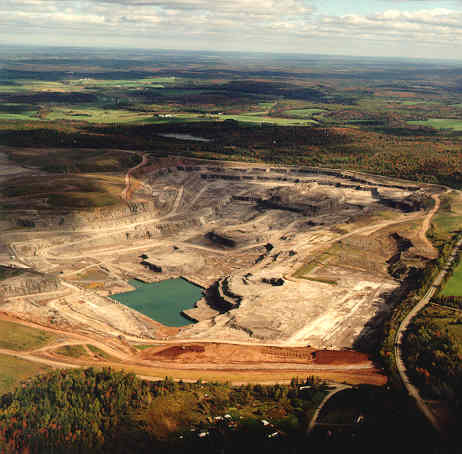Here and there across Nova Scotia, white gypsum cliffs rise among
the green spruce. The soft white rocks can be scraped with your
fingernail or broken in your hands. Gypsum, a soft sedimentary rock
mineral, consists of calcium sulphate chemically combined with
water (calcium sulphate dihydrate, or CaSO4.2H2O). It is commonly
white or light brown in colour, and forms through the evaporation
of salt waters. Nova Scotia's major gypsum resources are located on
the northern mainland and Cape Breton Island in a geological unit
called the Windsor Group. These deposits were created 350 to 335
million years ago, when an inland sea became very "salty" due to
evaporation in a hot dry climate. Large amounts of gypsum and
anhydrite (calcium sulphate), salt (halite-sodium chloride) and
limestone (calcium carbonate) were precipitated from the dense
"salty" sea water. Huge deposits of limestone, salt and
gypsum/anhydrite were created by evaporation from these ancient
seas.

Mining of these thick gypsum deposits has made Nova Scotia the
world's most productive gypsum mining region. In the quarry,
resting on gypsum bedrock, is a record of Pleistocene sediments
dating back 209 ka (ka = 1000 years ago). There was a major ice
advance approximately 209 ka, followed by a lengthy warm period
called an interglacial. During this period, which lasted from 125
to 79 ka, the climates in Nova Scotia fluctuated from as warm as
southern Georgia, USA, to as cold as northern Quebec. During the
last cold phase of the interglacial, mastodons roamed Nova Scotia,
and one fell in some muck in a sinkhole and died. Later, several
glaciers passed over the quarry and the mastodon protected in the
sinkhole, covering it with 30 m of glacial deposits. The National
Gypsum Company stripped off these glacial deposits to reveal the
beast. In 1991, Stanley McMullin, a grader operator, noticed a tusk
in some fill that he was excavating from a sinkhole. Scientists
from the Nova Scotia Museum eventually uncovered the nearly
complete remains of an adult and juvenile Mastodon ( Mammut
americanum). These include skull, (with tusk and teeth
disarticulated), scapula, thoracic vertebra, ribs and femur bone
fragments (Grantham and Kozera-Gillis, 1992). A few pollen samples
from the sinkhole organics revealed a homogenous conifer-dominated
assemblage, consistent with a cool boreal forest environment. Wood
( Pinus banksiana) found near the mastodon bones was dated at
>51 ka .
See what a reconstructed mastodon looks like
here, standing guard over a local shopping centre.
Thanks to the Nova Scotia Department of Natural Resources for
permission to use the images and text.
For more information visit NSDNR
To log this
EarthCache :
1) Take a photograph of yourself and or group, with the quarry on
the background.
2) answer the following questions and email the cache owner with
the answers.
-How many tonnes of Gypsum are produced from this quarry each year?
(National Gypsum Canada Ltd.)
-At the EarthCache cordinates, examine the 2 large mineral
outcroppings. Describe what you find.
-What year were the mastodon bones discovered in this quarry?
Gypsum (CaSO42H4.O)
The word gypsum is derived from the Greek "gypsos" meaning chalk.
Crystals are tabular or diamond-shaped with beveled edges.
Physical Properties
1. Hardness - 2
2. Specific gravity - 2.32
3. Luster - usually vitreous; also pearly and silky
4. Colour - colourless, white, grey: various shades of yellow, red,
brown from impurities, transparent or translucent
5. Texture - Satin spar is a fibrous gypsum with silky luster;
Alabaster is the fine-grained massive variety; Selenite is a
variety that yields broad colourless and transparent crystals.
 Want to be further rewarded for
visiting EarthCache sites around our planet?
Then why not become involved in the exciting new EarthCache
Masters program. Just visit three or more EarthCache sites
(view guidelines)
to start being sent special collectable EarthCache Masters
pins. There are four levels to strive to own — Bronze,
Silver, Gold and Platinum. Its free and easy to participate!
Come join in the fun.
Want to be further rewarded for
visiting EarthCache sites around our planet?
Then why not become involved in the exciting new EarthCache
Masters program. Just visit three or more EarthCache sites
(view guidelines)
to start being sent special collectable EarthCache Masters
pins. There are four levels to strive to own — Bronze,
Silver, Gold and Platinum. Its free and easy to participate!
Come join in the fun.
To visit an Earthcache near you, click on the Earthcache
Listings, and find a site that interests you.

